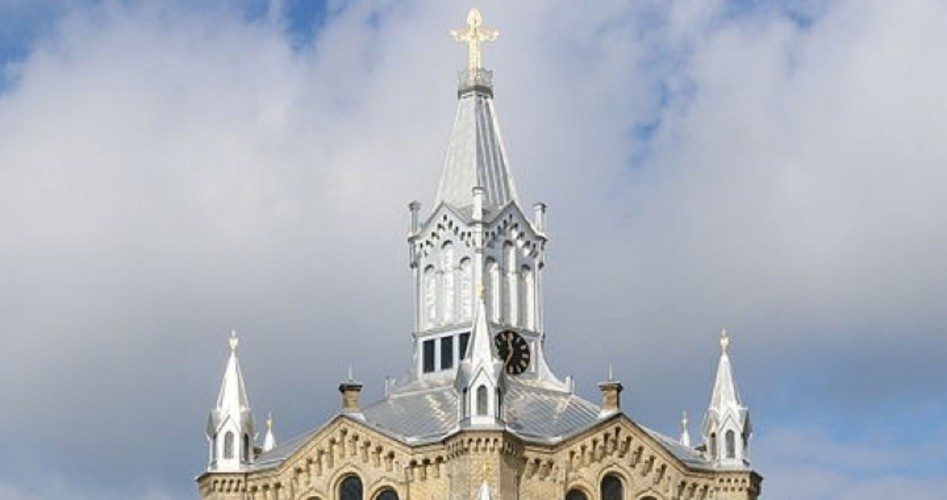
With “transitioning” in today, the Church of Sweden has joined the “gay” fray and is busy transitioning into a thoroughly “modern” institution. The latest example is how a Malmo church has just unveiled a new altarpiece: a painting titled Paradise that recasts Adam and Eve as two same-sex couples — tempted by a MUSS (Made-up Sexual Status or “transgender”) serpent.
“The controversial work of art is not new,” reports RT. “Photographer and artist Elisabeth Ohlson Wallin painted it in 2012 and tried to donate it to the Skara Cathedral just before the church was preparing to conduct the first same-sex wedding in its 1,000-year history.”
“The openly lesbian artist, who has a history of blending religious imagery with pro-minority activism, said at the time that she wanted to test if the Church of Sweden was as gay-friendly as it claimed to be when it embraced same-sex marriage in 2009,” the site continued. “The Skara Cathedral politely declined the gift, saying it was about political activism and not faith.”
“But over seven years have passed, and now Wallin has got her way, even if it isn’t in her home city. St. Paul’s Church in Malmo accepted the painting … and unveiled it on Sunday, the first day of Advent,” RT also informs.
Helena Myrstener, the pastor, tweeted a photo of the art along with an approving statement reading (auto-translated; tweet below), “On Sunday, history is written. Sweden’s only LGBT altarpiece (Elisabeth Ohlsson [sic] Wallin) is received in St. Paul’s church in M-island. Of course, it hangs in the choir, next to the ‘old’ altarpiece. We are so happy and proud!”
På söndag skrivs historia. Sveriges enda hbtq-altartavla (Elisabeth Ohlsson Wallin) tas emot i S:t Pauli kyrka i M-ö. Självklart hänger den i koret, bredvid den ”gamla” altartavlan. Vi är så glada o stolta! pic.twitter.com/W5TBkL8osa
— helena myrstener ? (@helenamyrstener) November 27, 2019
Of course, Genesis states that God “created them male and female,” not anything in-between or “fluid,” and the Bible is clear in proscribing homosexual behavior.
What’s interesting, though, is the serpent’s MUSS status. This doesn’t exactly seem flattering — or politically correct — given that the figure symbolizes pure evil. In fact, it smacks of the androgynous portrayal of Satan in the 2004 film The Passion of the Christ (video below) and may actually be theologically acceptable. As that movie’s producer, Mel Gibson, explained, “That’s what evil is about, taking something that’s good and twisting it a little bit.”
Speaking of which, ChristianAction.org wrote that with the altered altarpiece Sweden has done the “unthinkable.” Yet it wasn’t unexpected, as the Nordic land is essentially now an atheist nation.
As the Local reported in 2015, “Almost eight out of ten Swedes are either ‘not religious’ or ‘convinced atheists’, according to a new global study that concludes the Nordic nation is the least religious in the West.”
“Swedes’ beliefs contrast dramatically with the vast majority of most other nationalities on the planet, with more than six out of ten people surveyed across 65 different countries describing themselves as ‘religious,’” the site continued.
Only China, Hong Kong, and Japan appear “to have a greater proportion of atheists than Sweden,” the Local also informs.
In fact, insofar as Swedes still belong to the Church of Sweden, it’s often merely because they’re “supporting the social work we are doing,” the Local quotes a church official as saying.
Myrstener’s Twitter bio reflects this, too, stating, “Pastor of St. Paul’s Church in Malmö, specializing in arts and culture.” With “saving souls, inculcating faith, and encouraging virtue” not even mentioned, it’s a good example of why writer Bret Stephens once noted that the West today believes in “shallow things, shallowly.”
This doesn’t mean religion is dying in Sweden, though — mosque attendance is “rising thanks to growing numbers of immigrants arriving in Sweden from the middle east [sic] in recent years,” the Local also reported.
In fact, it’s almost tragically poetic that the un-Christian altarpiece appears in Malmo. Sweden’s second mosque was built in that city in 1984, and the locality now has a large Muslim population; high crime; and is an example of how, admits Bloomberg media, the “Arab Street” has come to the Nordic country. It’s as if Malmo’s St. Paul’s Church/Muslim faith dichotomy symbolizes Sweden’s overall cultural, religious, and demographic transformation.
But while the post-Christian cultural collapse is most advanced in Sweden, it’s evident across the West. Note that five in ten Western Europeans overall describe themselves as “not religious” or “a convinced atheist,” the Local further relates.
Politically passionate but “religiously neutral” people may wonder why this matters. Well, note that while it’s often pointed out how politics is downstream of culture, overlooked is that politics and culture are downstream of “First Things”: faith and philosophy.
Thus is church attendance one of the best predictors of voting patterns, with regular service-goers breaking widely for the GOP and atheists being largely Democrat; it’s why there’s a strong direct correlation between Christian lassitude and leftism in Western nations, with the more atheistic invariably being more liberal. Sweden is Exhibit A, being a land where godless leftists have proposed lunacy such as a “Man Tax“ and policies designed to pressure boys and men into urinating sitting down (seriously) to strike a blow against “male dominance.”
The bottom line is that people will worship the spirit of the age or of the ageless. In the West it’s currently the former, which accounts for altered altarpieces, altered demographics, and for why, now, the civilization is not aging very well.
Photo showing St. Paul’s Church in Malmo, Sweden: Jorchr
Selwyn Duke (@SelwynDuke) has written for The New American for more than a decade. He has also written for The Hill, Observer, The American Conservative, WorldNetDaily, American Thinker, and many other print and online publications. In addition, he has contributed to college textbooks published by Gale-Cengage Learning, has appeared on television, and is a frequent guest on radio.

